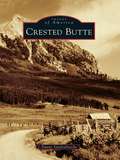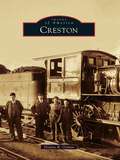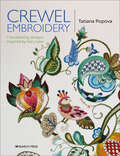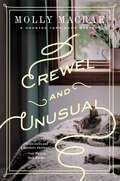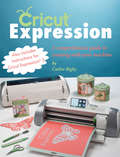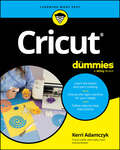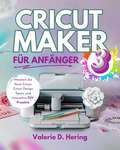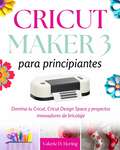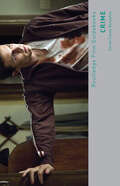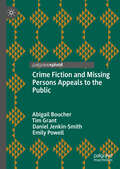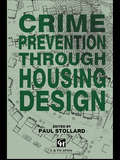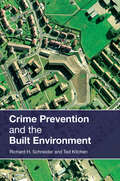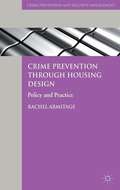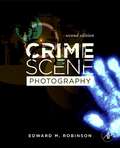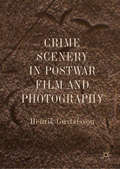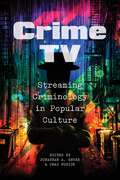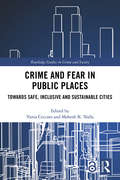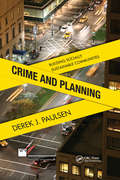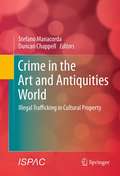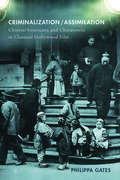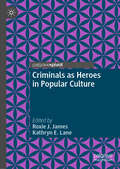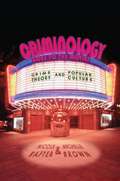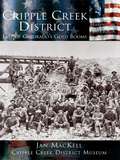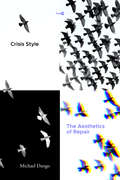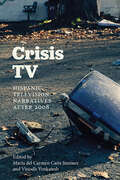- Table View
- List View
Crested Butte
by Crested Butte Mountain Heritage Museum Duane Vandenbusche Gunnison Pioneer Museum Crested Butte Mountain ResortCrested Butte rises 8,885 feet above sea level on the edge of the beautiful Elk Mountains in the Gunnison Country of Colorado's Western Slope. Between Crested Butte and Aspen, 25 miles to the north, are six 14,000-foot-high peaks with 12,000-foot-high passes and scenery that takes the breath away. Crested Butte began as a silver camp but soon turned into one of the great coal towns of the West, with a rich ethnic heritage evolved from the mining camps. In the 21st century, Crested Butte is a tourist town of 1,500 residents highlighted by the Mount Crested Butte Ski Area, the Mountain Bike Hall of Fame, and its wonderful wildflower and music festivals. The town today is what it always has been, "the queen jewel of the Elk Mountains."
Creston
by Dianne R. OsmunCreston sprang to life on the summit of the high prairie, where railroad officials pitched their camp one night in 1868. Creston was chosen as the division point between the Mississippi and the Missouri Rivers. The railroad brought its machine shops; roundhouse, and a rip-roaring, brawling construction camp to the new town. By 1869, the area was platted and construction began. Creston became an overnight industrial and transportation center, earning the nickname of "Little Chicago." In 1879, Robert Louis Stevenson implied that the Wild West began in Creston. He reported his first encounter with the open display of handguns in Creston when a passenger, without a ticket, was thrown from a moving train. He later wrote, "They were speaking English all around me, but I knew I was in a foreign land. It was the first indication that I had come among revolvers, and I observed it with some emotion."
Crewel Embroidery: 7 Enchanting Designs Inspired by Fairytales
by Tatiana PopovaLearn to create stunning needlecraft projects inspired by traditional fairy tales, including The Wizard of Oz, Karolcia, The Wild Swans, and Cinderella.This magical collection takes as its central theme a magnificent embroidery depicting the &“Tree of Happiness.&” Each part of the embroidery is then explored in detail through stitch diagrams, explanations of the threads used, and alternative ways of working. There are seven wonderful designs in total, each dedicated to one of Tatiana&’s favorite fairy tales, and all illustrated with gorgeous photographs and informative diagrams.Over 90 stitches are described in the book, all worked using stranded cotton and cotton pearl thread rather than traditional crewel wool, which gives the embroideries a fresh, modern appeal. Whether you are new to embroidery or an experienced embroiderer looking for inspiration and expert guidance, Tatiana&’s beautiful book is one you will turn to again and again.&“Tatiana Popova is a major craftswoman in her art, and what she does is beautiful. She not only demonstrates the techniques of crewel, she simplifies and breakdown each design into small achievable parts.&” —Postcard Reviews
Crewel and Unusual: A Haunted Yarn Shop Mystery (Haunted Yarn Shop Mystery Series #6)
by Molly MacRaeThe latest mystery in this charming mystery series finds the ever-resourceful Kath Rutledge and shop ghost Geneva tangled up in an embroidery rivalry—and a murder. Yarn shop owner Kath Rutledge is looking forward to the grand opening of the Blue Plum Vault, a co-op of small shops on Main Street. But in the week before the grand opening, Kath and her needlework group, TGIF (Thank Goodness It’s Fiber), hear rumors of an unpleasant rivalry developing between two of the new shopkeepers. Nervie Bales and Belinda Moyer declare each other’s embroidery patterns and antique embroidered linens fakes, copies—and stolen goods. Kath is caught in the middle when she’s asked to use her textile expertise to decide if there’s any truth to the accusations. Then, the day before the grand opening, an exquisite tablecloth that Kath has fallen in love with—the pride of Belinda’s shop—is found cut to shreds. Belinda accuses Nervie of the outrage, but Nervie has an airtight alibi: she was at Kath’s shop, the Weaver’s Cat, teaching a crewel embroidery class. Despite worries over the rivalry and vandalism, the opening is a success—until Belinda is found dead, stabbed in the back with a pair of scissors from the Weaver’s Cat. Geneva, the ghost who haunts Kath’s store, claims she saw the murderer leaving the scene of the crime. But the ghost is the ultimate unreliable witness—only Kath and her shop manager can see or hear her. That means it’s up to Kath, TGIF, and especially Geneva the ghost to solve the crime before the killer cuts another life short.
Cricut Expression: A Comprehensive Guide to Creating with Your Machine
by Cathie RigbyCreate amazing papercrafts with this comprehensive guide for beginners and advanced Cricut™ users. In a clear and accessible way, Cathie Rigby teaches the basics of the Cricut Expression™ machines (both the original and the new Cricut Expression™ 2) and cutting for beginners. For advanced crafters, this book instructs on features such as modes and functions, and teaches how to create with color, texture, and dimension. A cutting guide teaches the perfect settings to cut every type of material. A separate chapter introduces the new features of Cricut Expression™ 2 and explains how it differs from the original Expression machine. More than 50 creative projects inspire ideas for home décor, gifts, parties, cards, and scrapbook layouts. Cathie Rigby has taught Cricut, Design Studio, and Gypsy classes for four years in the Salt Lake City area. She currently teaches at Roberts Arts & Crafts and Hobby Lobby stores and hosts scrapbook retreats and Cricut Cruises.
Cricut For Dummies
by Kerri AdamczykYour simple guide to the DIY die-cutting machine that lets you create without limitations Your new Cricut can help you cut paper, vinyl, fabric, and beyond. Perfect for DIY enthusiasts, scrapbookers, and professional designers, Cricut machines are favorites among makers of all types. Cricut For Dummies gives you clear, simple instructions for using a Cricut machine, so you can start creating today. You'll learn how to achieve intricate, precise cuts, much faster than would be possible by hand. This step-by-step guide shows you how to make greeting cards, fun labels, personalized clothing, stickers, and even unique wood or leather goods. Don't have your Cricut yet? No problem! Cricut For Dummies explains the differences between the models and how to choose the best machine for your needs. Use the Design Space app and the Cricut design library to create successful projects Choose, set up, and operate your Cricut machine Choose a machine based on the type of material you will be using Get suggestions for fun projects at every skill level This book is for anyone who wants to learn how to use a Cricut machine to design, create, or perfect their craft. Cricut For Dummies is ideal for beginners who have no experience using a cutting machine, and it's a handy reference for those who want to improve their Cricut skills.
Cricut Maker 3 für Anfänger: Meistern Sie Ihren Cricut, Cricut Design Space und innovative DIY-Projekte
by Valerie D. HeringWillkommen in der wunderschönen Welt des Cricut Maker! Dieser Leitfaden wurde zusammengestellt, um Ihnen dabei zu helfen, sich in der Bastelwelt von Cricut und den zahlreichen und faszinierenden Funktionen des Cricut-Geräts zurechtzufinden, damit Sie im Handumdrehen mit der Umsetzung einzigartiger DIY-Projekte beginnen können! Sie waren bestimmt auf der Suche nach einem Buch, das all Ihren Bastelbedürfnissen gerecht wird; Sie sind an der richtigen Stelle. Dieses Handbuch zeigt Ihnen, wie Sie Ihre Cricut-Maschine einrichten, mit Holz, Vinyl, Leder, Papier usw. arbeiten. Das Zusammenstellen dieser genialen Designs kann Ihre Fähigkeiten oft an die Grenzen bringen, wenn Ihr Schneidegerät nicht leicht zu verstehen ist. Verzweifeln Sie nicht, denn dieses Buch deckt alle Aspekte ab und bietet Ihnen umfassende Lektionen zur richtigen und einfachen Verwendung Ihres Cricut Makers. Jeder Abschnitt dieses Buches wurde speziell für Sie zusammengestellt, um Ihnen dabei zu helfen, praktische Erfahrungen zu sammeln und sich mit Ihrem neuen Gerät vertraut zu machen Cricut Maker 3. Sie werden intelligente Möglichkeiten entdecken, Funktionen wie den Cricut Design Space, benutzerdefinierte Materialeinstellungen, die Verwendung des besten Zubehörs für jedes Projekt und vieles mehr zu nutzen. Wenn Sie den Cricut Maker mit dem Cricut Explore Air oder Cricut Joy vergleichen, werden Sie feststellen, dass er leistungsstärker und hinsichtlich der Steuerung und anderer Funktionen etwas fortschrittlicher ist. Daher wurde der Fokus auf die kleinsten Details gelegt, um sicherzustellen, dass sowohl Neulinge als auch erfahrene Leute so schnell wie möglich das Beste herausholen können. Hier finden Sie eine Zusammenfassung dessen, was Sie von diesem Buch erwarten; - Einrichten Ihres Cricut Maker 3 - Machen Sie sich mit dem Gerät vertraut - Spielen im Design Space - Ve
Cricut Maker 3 para principiantes: Domina tu Cricut, Cricut Design Space y proyectos innovadores de bricolaje
by Valerie D. Hering¡Bienvenido al hermoso mundo de Cricut Maker! Esta guía se ha elaborado para ayudarte a navegar por el mundo artesanal de Cricut, las numerosas e intrigantes funcionalidades del dispositivo Cricut, para que puedas comenzar a realizar proyectos de bricolaje únicos en poco tiempo. Debes haber estado buscando un libro que satisfaga todas tus necesidades de manualidades; Has venido al lugar correcto. Este manual le mostrará cómo configurar su máquina Cricut, trabajar con madera, vinilo, cuero, papel, etc. La mayoría de las veces, armar esos diseños ingeniosos puede llevar sus habilidades al límite cuando su dispositivo de corte no es fácil de comprender. No se desespere, ya que este libro cubre todos los ángulos en un intento de brindarle lecciones completas sobre la manera adecuada y fácil de utilizar su Cricut Maker. Cada sección de este libro se ha elaborado pensando en usted para ayudarle a adquirir experiencia práctica y a establecerse con su nuevo Cricut Maker 3. Descubrirá formas inteligentes de utilizar funciones como Cricut Design Space, configuraciones de materiales personalizadas, utilizar los mejores accesorios para cada proyecto y mucho más. Cuando comparas Cricut Maker con Cricut Explore Air o Cricut Joy, descubrirás que es más potente y un poco más avanzado en su control y otras funciones. Por lo tanto, se ha prestado atención a los detalles más pequeños para garantizar que tanto los principiantes como los experimentados puedan dar el mejor paso lo antes posible. Aquí hay un resumen de lo que obtendrá de este libro.; Configurando tu Cricut Maker 3 Familiarizarse con el dispositivo Jugando con el espacio de diseño Conexión de su dispositivo móvil o PC con su Cricut Maker Usar bolígrafos Cricut Carga y descarga de su tapete Cricut Accesorios y herramientas necesarias Trabajar con una variedad de tipos de materiales en su Cricut (Trabajar con vinilo, Trabajar con HTV) Proye
Crime (Routledge Film Guidebooks)
by Sarah Casey BenyahiaCrime films have, since the earliest days of cinema, been popular with audiences, industry and critics alike and encompassed a diverse range of subjects, styles and themes. The genre provides a range of pleasures for the spectator, from taking on the role of the detective in the pursuit of clues in the ‘whodunit’, to the more illicit thrills of identification with an anti hero. In the many incarnations of the crime film such as the gangster, film noir, political and detective thrillers, the genre explores the anxieties of different historical moments. Sarah Casey Benyahia provides an overview of the development of the crime film and examines the key theories and ideas involved in the study of the genre. These include; the investigative structure and narration of the crime film, the aesthetics of violence and issues of representation and ideology. These areas are explored through contemporary and classic, Hollywood and European cinema with case studies on the history of the genre, the role of the detective, the 'family crime' film and the conspiracy thriller. Crime provides a broad framework to the study of the genre through the introduction of narrative, genre and audience theories as well as detailed analysis of specific films. Films discussed include: Scarface (1932) Mildred Pierce (1945) Dirty Harry (1971) The Parallax View (1974) Reservoir Dogs (1992) Mystic River (2002) Hidden (2005) Gone Baby Gone (2007) Zodiac (2007) The Millennium Trilogy (2009) The Secret in Their Eyes (2010)
Crime Fiction and Missing Persons Appeals to the Public
by Tim Grant Emily Powell Abigail Boucher Daniel Jenkin-SmithThis book draws upon genre fiction studies, forensic linguistics, and media studies to investigate the overlap between crime fiction conventions and the writing of missing persons appeals to the public. This book is based on a pilot project funded by the Aston Institute for Forensic Linguistics, entitled 'Genre, Pacing, and Narrative in Police Missing Persons Appeals' (Aug 2021-Nov 2022). The authors identify a missing persons appeal as a literary and linguistic genre in its own right and illustrate the problems that arise when the appeals writing process goes unregulated or unstudied: there is currently little-to-no official, national police guidance, regulation, or standard procedure for writing a missing persons appeal in the UK. The authors also identify opportunities for improving the writing and delivery of appeals by further (and more intentionally) applying crime fiction conventions, narrative devices, and pacing, to maximise audience reach and increase the chances of recovering a missing person. This book will be of particular interest to genre fiction scholars (particularly those interested in crime fiction), forensic linguists, and media studies scholars.
Crime Prevention Through Housing Design
by Paul StollardThis book provides specific guidance for architects, planners, and housing managers on designing to deter crime. While every estate and neighbourhood has different problems which require unique solutions, the process which leads to the solutions will be the same. This book provides specific guidance for architects, planners, and housing managers on designing to deter crime. While every estate and neighbourhood has different problems which require unique solutions, the process which leads to the solutions will be the same.The first three chapters review the various theories of crime prevention through design, and abstract from them a series of six key principles which can be applied to all housing projects. The remaining five chapters outline the practical application of these principles in the assessment, design and construction processes.The text of this book has been compiled and updated from two educational packages produced by the Institute of Advanced Architectural Studies and the Safe Neighbourhoods Unit. These were Safe as Houses (1988) and Safer Neighbourhoods (1989). Videos produced as part of those educational packages are available for use with this book.
Crime Prevention and the Built Environment
by Richard H. Schneider Ted KitchenWith a comprehensive analysis, this book links theory, evidence and practical application to bridge gaps between planning, design and criminology. The authors investigate connections between crime prevention and development planning with an international approach, looking at initiatives in the field and incorporating an understanding of current responses to the growth of technology and terrorism.
Crime Prevention through Housing Design
by Rachel ArmitageThis book presents a comprehensive review of the impact of residential design on crime focusing upon research, policy and practice both in the UK and internationally, appealing to both academics and practitioners within the fields of crime prevention, urban planning and architecture.
Crime Scene Photography (Second Edition)
by Edward M. RobinsonCrime Scene Photography, Second Edition covers the general principals and concepts of photography, while also delving into the more practical elements and advanced concepts of forensic photography. Edward Robinson assists the reader in understanding and applying essential concepts in order to create images that are able to withstand challenges in court. The first part of the book deals with the basic theory and science of photography required to take superior photographs, and covers topics such as composition, exposure, focus, depth of field, and flash techniques. The second part of the text deals specifically with the challenges of photographing a crime scene, including instructions on how to document bodies and wounds, traffic accident photography, underwater photography and aerial photography. In the latter portions of the text, the author turns to digital theory and its advantages and disadvantages. * Over 600 full color photographs, also electronically available on the companion website * Two new chapters on 'The History of Forensic Photography,' and 'Digital Image Processing of Evidentiary Photography' * Includes an Instructor website with lecture slides, practical exercises, a test bank and image collection * An essential reference for crime scene photography, including topics such as Composition, the Inverse Square Law, Court Cases affecting photography, Digital Image Processing, and Photogrammetry * Required reading by the Crime Scene Certification Board of the International Association for Identification (IAI) for all levels of certification
Crime Scenery in Postwar Film and Photography
by Henrik GustafssonThis book offers a rare and innovative consideration of an enduring tendency in postwar art to explore places devoid of human agents in the wake of violent encounters. To see the scenery together with the crime elicits a double interrogation, not merely of a physical site but also of its formation as an aesthetic artefact, and ultimately of our own acts of looking and imagining. Closely engaging with a vast array of works made by artists, filmmakers and photographers, each who has forged a distinct vantage point on the aftermath of crime and conflict, the study selectively maps the afterlife of landscape in search of the political and ethical agency of the image. By way of a thoroughly interdisciplinary approach, Crime Scenery in Postwar Film and Photography brings landscape studies into close dialogue with contemporary theory by paying sustained attention to how the gesture of retracing past events facilitates new configurations of the present and future.
Crime TV: Streaming Criminology in Popular Culture
by Ben Jones Eduardo MendietaFrom Game of Thrones to Breaking Bad, the key theories and concepts in criminal justice are explained through the lens of televisionIn Crime TV, Jonathan A. Grubb and Chad Posick bring together an eminent group of scholars to show us the ways in which crime—and the broader criminal justice system—are depicted on television. From Breaking Bad and Westworld to Mr. Robot and Homeland, this volume highlights how popular culture frames our understanding of crime, criminological theory, and the nature of justice through modern entertainment. Featuring leading criminologists, Crime TV makes the key concepts and analytical tools of criminology as engaging as possible for students and interested readers. Contributors tackle an array of exciting topics and shows, taking a fresh look at feminist criminology on The Handmaid’s Tale, psychopathy on The Fall, the importance of social bonds on 13 Reasons Why, radical social change on The Walking Dead, and the politics of punishment on Game of Thrones. Crime TV offers a fresh and exciting approach to understanding the essential concepts in criminology and criminal justice and how theories of crime circulate in popular culture.
Crime and Fear in Public Places: Towards Safe, Inclusive and Sustainable Cities (Routledge Studies in Crime and Society)
by Vania Ceccato Mahesh K. NallaThe Open Access version of this book, available at https://www.taylorfrancis.com/books/9780429352775 has been made available under a Creative Commons Attribution-Non Commercial-No Derivatives 4.0 license. No city environment reflects the meaning of urban life better than a public place. A public place, whatever its nature—a park, a mall, a train platform or a street corner—is where people pass by, meet each other and at times become a victim of crime. With this book, we submit that crime and safety in public places are not issues that can be easily dealt with within the boundaries of a single discipline. The book aims to illustrate the complexity of patterns of crime and fear in public places with examples of studies on these topics contextualized in different cities and countries around the world. This is achieved by tackling five cross-cutting themes: the nature of the city’s environment as a backdrop for crime and fear; the dynamics of individuals’ daily routines and their transit safety; the safety perceptions experienced by those who are most in fear in public places; the metrics of crime and fear; and, finally, examples of current practices in promoting safety. All these original chapters contribute to our quest for safer, more inclusive, resilient, equitable and sustainable cities and human settlements aligned to the Global 2030 Agenda for Sustainable Development.
Crime and Planning: Building Socially Sustainable Communities
by Ph.D., Derek PaulsenThe form and layout of a built environment has a significant influence on crime by creating opportunities for it and, in turn, shaping community crime patterns. Effective urban planners and designers will consider crime when making planning and design decisions. A co-publication with the American Planning Association, Crime and Planning:
Crime in the Art and Antiquities World: Illegal Trafficking in Cultural Property
by Stefano Manacorda Duncan ChappellThe theft, trafficking, and falsification of cultural property and cultural heritage objects are crimes of a particularly complex nature, which often have international ramifications and significant economic consequences. Organized criminal groups of various types and origins are involved in these illegal acts. The book Crime in the Art and Antiquities World has contributions both from researchers specializing in the illegal trafficking of art, and representatives of international institutions involved with prevention and detection of cultural property-related crimes, such as Interpol and UNESCO. This work is a unique and useful reference for scholars and private and public bodies alike. This innovative volume also includes an Appendix of the existing legal texts, i.e. international treaties, conventions, and resolutions, which have not previously been available in a single volume. As anyone who has undertaken research or study relating to the protection of cultural heritage discovers one of the frustrations encountered is the absence of ready access to the multi- various international instruments which exist in the field. Since the end of the Second World War these instruments have proliferated, first in response to increasing recognition of the need for concerted multinational action to give better protection to cultural property during armed conflict as well as ensuring the repatriation of cultural property looted during such conflict. Thus the international community agreed in 1954 upon a Convention for the Protection of Cultural Property in the Event of Armed Conflict. That Convention, typically referred to as the Hague Convention of 1954, is now to be found reproduced in the Appendix to this book (Appendix I) together with 25 other important and diverse documents that we believe represent a core of the essential international sources of reference in this subject area. In presenting these documents in one place we hope that readers will now experience less frustration while having the benefit of supplementing their understanding and interpretation of the various instruments by referring to individual chapters in the book dealing with a particular issue or topic. For example, Chapter 9 by Mathew Bogdanos provides some specific and at times rather depressing descriptions of the application in the field of the Hague Convention 1954, and its Protocols (Appendices II and III), to the armed conflict in Iraq. Reference may also be had to the resolution of the UN Security Council in May 2003 (Appendix VI) urging Member States to take appropriate steps to facilitate the safe return of looted Iraqi cultural property taken from the Iraq National Museum, the National Library and other locations in Iraq. Despite such pleas the international antiquities market seems to have continued to trade such looted property in a largely unfettered manner, as demonstrated by Neil Brodie in Chapter 7. Fittingly, as referred to in the Preface to this book, the last document contained in the Appendix (Appendix 26) is the "Charter of Courmayeur", formulated at a ground breaking international workshop on the protection of cultural property conducted by the International Scientific and Professional Advisory Council (ISPAC) to the United Nations Crime Prevention and Criminal Justice Program in Courmayeur, Italy, in June 1992. The Charter makes mention of many of the instruments contained in the Appendix while also foreshadowing many of the developments which have taken place in the ensuing two decades designed to combat illicit trafficking in cultural property through international collaboration and action in the arena of crime prevention and criminal justice.
Criminalization/Assimilation: Chinese/Americans and Chinatowns in Classical Hollywood Film
by Philippa GatesCriminalization/Assimilation traces how Classical Hollywood films constructed America’s image of Chinese Americans from their criminalization as unwanted immigrants to their eventual acceptance when assimilated citizens, exploiting both America’s yellow peril fears about Chinese immigration and its fascination with Chinatowns. Philippa Gates examines Hollywood’s responses to social issues in Chinatown communities, primarily immigration, racism, drug trafficking, and prostitution, as well as the impact of industry factors including the Production Code and star system on the treatment of those subjects. Looking at over 200 films, Gates reveals the variety of racial representations within American film in the first half of the twentieth century and brings to light not only lost and forgotten films but also the contributions of Asian American actors whose presence onscreen offered important alternatives to Hollywood’s yellowface fabrications of Chinese identity and a resistance to Hollywood’s Orientalist narratives.
Criminals as Heroes in Popular Culture
by Kathryn E. Lane Roxie J. JamesThis book delves into humanity’s compulsive need to valorize criminals. The criminal hero is a seductive figure, and audiences get a rather scopophilic pleasure in watching people behave badly. This book offers an analysis of the varied and vexing definitions of hero, criminal, and criminal heroes both historically and culturally. This book also examines the global presence, gendered complications, and gentle juxtapositions in criminal hero figures such as: Robin Hood, Breaking Bad, American Gods, American Vandal, Kabir, Plunkett and Macleane, Martha Stewart, Mary Read, Anne Bonny, Ocean’s 11, Ocean’s Eleven, and Let The Bullets Fly.
Criminology Goes to the Movies: Crime Theory and Popular Culture
by Nicole Rafter Michelle BrownA &“deftly written and absorbing&” look at how films reflect concepts in criminology and affect our perceptions of criminal behavior (Richard Rosenfeld, coauthor of Crime and the American Dream). From Psycho to Double Indemnity to Thelma & Louise, Nicole Rafter and Michelle Brown show that criminological theory is produced not only in the academy through scholarly research, but also in popular culture through film. Criminology Goes to the Movies connects with ways in which students are already thinking criminologically through engagements with popular culture, encouraging them to use the everyday world as a vehicle for theorizing and understanding both crime and perceptions of criminality. The first work to bring a systematic and sophisticated criminological perspective to bear on crime films, Rafter and Brown&’s book provides a fresh way of looking at cinema using the concepts and analytical tools of criminology to uncover previously unnoticed meanings in film, ultimately making the study of criminological theory more engaging and effective for students while simultaneously demonstrating how theories of crime circulate in our mass-mediated worlds. With chapters focusing on films including Do the Right Thing, Capturing the Friedmans, and more, the result is an illuminating new way of seeing movies and a delightful way of learning about criminology.
Cripple Creek District: Last of Colorado's Gold Booms
by Cripple Creek District Museum Jan MackellThe Cripple Creek District, on the back of Pikes Peak in central Colorado, first found fame through Bob Womack, the cowboy who publicized his knowledge of gold in the high country and drew thousands to the area. Gold fever allowed the region to flourish, while strikes, fires, and economic hardships threatened the district's survival. The dwindling population's fortitude, plus innovative ideas to boost the economy, carried the city from a struggling gold-miners' paradise to a favored tourist spot.
Crisis Style: The Aesthetics of Repair (Post*45)
by Michael DangoIn this expansive and provocative new work, Michael Dango theorizes how aesthetic style manages crisis—and why taking crisis seriously means taking aesthetics seriously. Detoxing, filtering, bingeing, and ghosting: these are four actions that have come to define how people deal with the stress of living in a world that seems in permanent crisis. As Dango argues, they can also be used to describe contemporary art and literature. Employing what he calls "promiscuous archives," Dango traverses media and re-shuffles literary and art historical genealogies to make his case. The book discusses social media filters alongside the minimalism of Donald Judd and La Monte Young and the television shows The West Wing and True Detective. It reflects on the modernist cuisine of Ferran Adrià and the fashion design of Issey Miyake. And, it dissects writing by Barbara Browning, William S. Burroughs, Raymond Carver, Mark Danielewski, Jennifer Egan, Tao Lin, David Mitchell, Joyce Carol Oates, Mary Robison, and Zadie Smith. Unpacking how the styles of these works detox, filter, binge, or ghost their worlds, Crisis Style is at once a taxonomy of contemporary cultural production and a theorization of action in a world always in need of repair. Ultimately, Dango presents a compelling argument for why we need aesthetic theory to understand what we're doing in our world today.
Crisis TV: Hispanic Television Narratives after 2008 (SUNY series in Latin American and Iberian Thought and Culture)
by María del Carmen Caña Jiménez; Vinodh VenkateshCrisis TV addresses the motif of crisis that has come to dominate contemporary Hispanic televisual production since 2008 and the onset of the global financial crisis. In almost unprecedented fashion, the global economy came to a standstill, reshaping both geopolitical organizations and, more importantly, the lives of billions across the globe. The Great Recession, sociopolitical instabilities, the rise of extremist political parties and governments, and a worldwide pandemic have resulted in a mode of crisis that pervades contemporary television fiction. 2008 also marks a revolution in television, as local and global streaming services began to gain market share and even overtake traditional over-the-air transmission. The essays in Crisis TV identify and analyze the narrative tropes and aesthetic qualities of Hispanic television post-2008 to understand how different regions and genres have negotiated these intersecting crises and changing dynamics in production, dissemination, and consumption.
